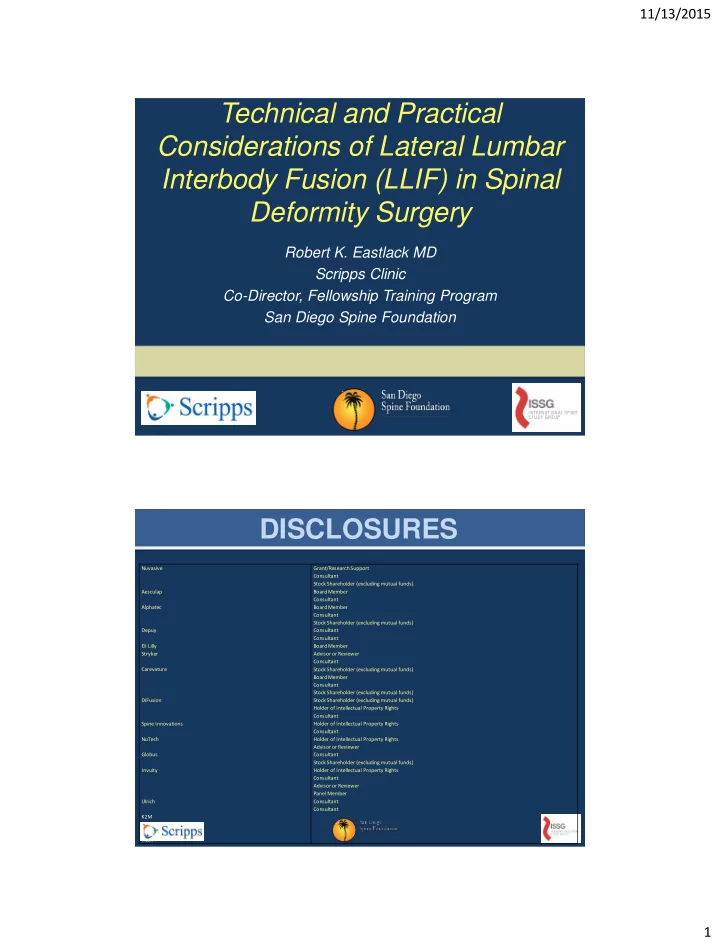

11/13/2015 Technical and Practical Considerations of Lateral Lumbar Interbody Fusion (LLIF) in Spinal Deformity Surgery Robert K. Eastlack MD Scripps Clinic Co-Director, Fellowship Training Program San Diego Spine Foundation DISCLOSURES Nuvasive Grant/Research Support Consultant Stock Shareholder (excluding mutual funds) Aesculap Board Member Consultant Alphatec Board Member Consultant Stock Shareholder (excluding mutual funds) Depuy Consultant Consultant Eli Lilly Board Member Stryker Advisor or Reviewer Consultant Carevature Stock Shareholder (excluding mutual funds) Board Member Consultant Stock Shareholder (excluding mutual funds) DiFusion Stock Shareholder (excluding mutual funds) Holder of Intellectual Property Rights Consultant Spine Innovations Holder of Intellectual Property Rights Consultant NuTech Holder of Intellectual Property Rights Advisor or Reviewer Globus Consultant Stock Shareholder (excluding mutual funds) Invuity Holder of Intellectual Property Rights Consultant Advisor or Reviewer Panel Member Ulrich Consultant Consultant K2M Titan 1
11/13/2015 Preoperative Planning • BASELINE SAGITTAL/CORONAL ALIGNMENT • ANTICIPATED CORONAL PLANE CHANGE – Beware of compensatory upper lumbar curve – Look for lumbosacral fractional curves – Anticipate effect of dysmorphic vertebral bodies PREOP PLANNING • Careful review of vascular, neural, renal/ureter anatomy (axial MRI/CT images) • Staged vs. same day posterior recon • L5-S1 – Interbody? – TLIF vs. ALIF? 2
11/13/2015 Beware Fractional Curves! Case Example • 73yo physician • LBP • Bilateral variable distribution radiculopathy • Progressive 3
11/13/2015 MRI No right L5 radiculopathy symptoms L4-5 L3-4 Options? • T-score: -0.3 • PI 48 • LL 28 • SVA 29mm • PT 28 4
11/13/2015 Intraop LLIF L2-5 EBL 30cc Immediate Postop PI 48 LL 28 PT 28 Resolved leg pain 5
11/13/2015 Options? • Need lordosis? • Correct coronal alignment • Osteotomies? • L5-S1? • Length of fusion/construct? Second Stage • ALIF L5-S1 • Perc fixation L2-S1 • Facet releases L2- 5 PI 48 LL 50 PT 19 EBL 250cc 6
11/13/2015 Case Example • 73yo female with progressive/chro nic LBP + RLE pain • Neuro intact • T score = -1.4 Multilevel DDD/foraminal stenosis 7
11/13/2015 Case Example • Look for balance – Coronal – Sagittal • What measures necessary to achieve alignment objectives? Intraop • 2.5hrs • EBL 50cc 8
11/13/2015 POSTOP • Ambulating POD 1 • Home POD 2 • TLSO • Mild hip flexion discomfort- resolved<10days • No neuro abnl • 2yrs postop--very pleased Preop Planning • Greater scrutiny on visceral/vascular structures on axial images • Determine renal/liver locations • Prior surgeries? – retroperitoneal 9
11/13/2015 MRI L1 L1 L4 L4 S1 S1 2014/5/19-20 L1/2 2014/5/19-20 10
11/13/2015 L2/3 2014/5/19-20 L3/4 2014/5/19-20 11
11/13/2015 L3/4 2014/5/19-20 L4/S1 2014/5/19-20 12
11/13/2015 Patient Positioning Considerations Concave or Convex Sided Approach in Scoliosis? Evaluate the degree of rotation Vascular/neural anatomy Minimizes number of incisions, but tight access to disc L4-5 not accessible from convex side For degenerative scoliosis cases: Clears the crest Approach on the concave side Better access to L4-L5 and collapsed side Small incision and exposure to access to multiple levels Psoas and plexus is more relaxed Better deformity correction Concave release 13
11/13/2015 Sequence of Laterals • L1-2 or L4-5 first – L1-2 first unless L4-5 aids in angle of approach to L1-2 • Then, work down – Avoids building away from your advantaged vector of approach/incision location 14
11/13/2015 Sample Case OR execution Review of Advanced Imaging L3-4 L4-5 Assess rotation of each level and potential effect of approach side 15
11/13/2015 Intraoperative Preparation • New AP optimized imaging for each level • Use caudal level as proxy for neutral rotation • Angled approach PRN Intraoperative Preparation • Table Trendelenberg for obtaining lateral profile view of disk space 16
11/13/2015 17
11/13/2015 Next Level L4-5 18
11/13/2015 Dealing with Overhangs Getting Docked 19
11/13/2015 Opening the Disk Space Dealing with Overhangs Osteotome or Cobb if needed to access disk space 20
11/13/2015 Using Cobb Elevators Safely • Flip the cobb to use the ‘soft’ edge POSTOP 21
11/13/2015 Case Example • 67yo female • 10 yrs prog LBP/leg pain • s/p B THA • T score -1.3 • Coronal cobb 33 deg • Choice in mgt? – Post only – A/P – LLIF/post – open vs. MIS • Staged vs. same day PI 52 LL 26 PT 30 22
11/13/2015 POSTOP 1yr EBL = 500 cc PI 52 LL 53 PT 19 X ray 23
11/13/2015 X ray MRI L2/3 L3/4 24
11/13/2015 CT BEWARE THE FRACTIONAL CURVE SUMMARY • Plan LLIF with radiographs and advanced imaging – Assess vascular/plexus anatomy – Beware fractional curves! • Typically go to concavity • Sequence laterals according to disk space accessibility and curve unfolding • Consider staging if alignment outcome uncertain 25
Recommend
More recommend